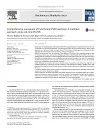Background
The detailed analysis of Cytochrome P450 (CYP) catalyzed reactions is of great interest, since those are of importance for biotechnical applications, drug interaction studies and environmental research. Often cocktail approaches are carried out in order to monitor several CYP activities in a single experiment. Commonly in these approaches product formation is detected and IC50 values are determined.
Methods
In the present work, the reactions of two different CYP isoforms were monitored using real-time electrospray ionization mass spectrometry. Multiplex experiments using the highly specific CYP2A6 with its corresponding substrate coumarin as well as the highly promiscuous CYP3A4 with testosterone were conducted. Product formation and substrate depletion were simultaneously monitored and compared to the single CYP experiments. The diffusion-controlled rate of reaction and conversion rates that are used as parameters to assess the enzymatic activity were calculated for all measurements conducted.
Results
Differences in conversion rates and the theoretical rate of reaction that were observed for single CYP and multiplex experiments, respectively, reveal the complexity of the underlying mechanisms. Findings of this study imply that there might be distinct deviations between product formation and substrate degradation when mixtures are used.
Conclusions
Detailed results indicate that for a comprehensive assessment of these enzymatic reactions both product and substrate should be considered.
General significance
The direct hyphenation of enzymatic reactions to mass spectrometry allows for a comprehensive assessment of enzymatic behavior. Due to the benefits of this technique, the entire system which includes substrate, product and intermediates can be investigated. Thus, besides IC50 values further information regarding the enzymatic behavior offers the opportunity for a more detailed insight.
